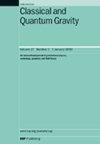利用同调延续求解离散引力中的面积-长度系统
IF 3.6
3区 物理与天体物理
Q2 ASTRONOMY & ASTROPHYSICS
引用次数: 0
摘要
面积变量是广义相对论连接公式的固有变量,而基本长度变量则普遍存在于度量公式中。在四维离散引力中,特别是在三角形的基础上,面积-长度系统建立了与三角形相关的面积变量和边长变量之间的关系。该系统由赫伦公式衍生的多项式方程组成,赫伦公式将三角形的面积与边长联系起来。我们利用数值代数几何工具研究了面积-长度系统。特别是,我们证明,给定一个四元组的十个三角形面积,可能有多达 64 个相容的边长集。此外,我们还通过分析问题的伽罗瓦群或单色群,证明这 64 个解一般不包含面积公式。我们证明,通过引入额外的对称约束,可以得到边长的计算公式。我们迈出了第一步,将我们的结果应用于离散量子引力,特别是有效自旋泡沫模型。本文章由计算机程序翻译,如有差异,请以英文原文为准。
Solving the area-length systems in discrete gravity using homotopy continuation
Area variables are intrinsic to connection formulations of general relativity, in contrast to the fundamental length variables prevalent in metric formulations. Within 4D discrete gravity, particularly based on triangulations, the area-length system establishes a relationship between area variables associated with triangles and the edge length variables. This system is comprised of polynomial equations derived from Heron’s formula, which relates the area of a triangle to its edge lengths. Using tools from numerical algebraic geometry, we study the area-length systems. In particular, we show that given the ten triangular areas of a single 4-simplex, there could be up to 64 compatible sets of edge lengths. Moreover, we show that these 64 solutions do not, in general, admit formulae in terms of the areas by analyzing the Galois group, or monodromy group, of the problem. We show that by introducing additional symmetry constraints, it is possible to obtain such formulae for the edge lengths. We take the first steps toward applying our results within discrete quantum gravity, specifically for effective spin foam models.
求助全文
通过发布文献求助,成功后即可免费获取论文全文。
去求助
来源期刊

Classical and Quantum Gravity
物理-天文与天体物理
CiteScore
7.00
自引率
8.60%
发文量
301
审稿时长
2-4 weeks
期刊介绍:
Classical and Quantum Gravity is an established journal for physicists, mathematicians and cosmologists in the fields of gravitation and the theory of spacetime. The journal is now the acknowledged world leader in classical relativity and all areas of quantum gravity.
 求助内容:
求助内容: 应助结果提醒方式:
应助结果提醒方式:


